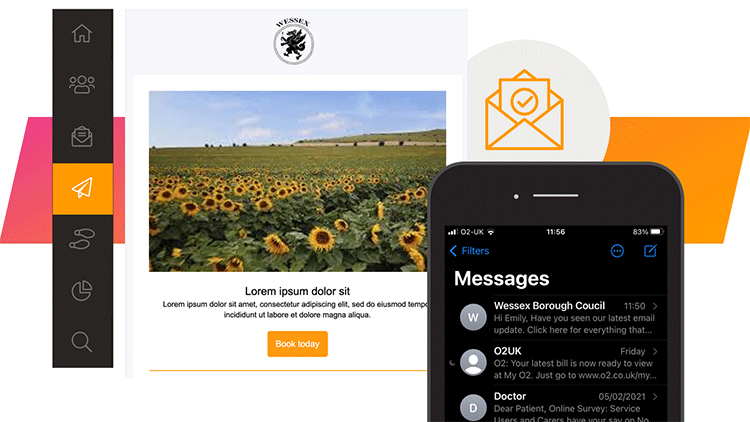Blog
CATEGORY: SMSBest practicePublic Sector
How the Public Sector can alert and engage with SMS

The value of SMS as a direct and effective marketing tool is well documented, but a growing number of public sector organisations are beginning to embrace it, for both practical and pragmatic reasons. So, if using, or increasing use of, SMS isn’t part of your digital transformation plan it might be time to rethink.
The capacity to deliver important information and urgent alerts straight into the hands of stakeholders is critical. Social inclusion, transparency and accountability are high on the agenda for public sector bodies, so to be able to deliver measurable, auditable and effective communication to citizens is imperative.
Research shows that over 98% of text messages are read, making SMS one of the most effective ways of communicating in today’s society. SMS also has the added advantage of reaching those residents who do not have sufficient access to the internet but do have a mobile phone.
Society has changed
The recent pandemic led to a near-universal need for public assistance—be it for an accurate count of cases in a specific area, where to locate testing or vaccination sites and guidance on restrictions and relief available, be it personal or professional. As the pandemic evolved, residents turned to their local governments for direction.
Public sector leaders face a common set of challenges if their services are to meet the increased expectations of their ‘customers’ – both citizens and businesses. And with those expectations changing and evolving, now more than ever, this challenge is all the greater.
Through SMS, communications can be timely, instantly acknowledged, personalised en-masse and highly targeted.
Connect and consult with SMS
More and more public sector organisations and local councils are embracing the value of text messaging to engage stakeholders, connecting people to their services and initiatives at a whole new level.
It is fast becoming an integral part of regular, effective and highly responsive communications with local residents. But many organisations are not using SMS to its full potential, seeing it as a transactional rather than broadcast channel offering citizens the chance to opt in to instantly receive the information that they are interested in.
Fast and efficient
Working with a text message provider can also help public bodies to disseminate emergency information more effectively than any other form of communication.
The impact of the pandemic has been two-fold in this regard. Public bodies have come to realise the importance of timely/instant effective communication and the public have become more reliant and accepting of communications being sent via SMS.
Personalisation
By using a bulk SMS provider, like e-shot for example, you can personalise messages, making recipients feel that their attention and response really counts for something. The personalisation can be as simple as their name, but it is possible to use any variable that you have in your database. It can also inspire far more responses and gather data in an extremely efficient way, increasing participation by the public.
Easy update and response mechanism
SMS services can also provide automated responses either individually or as part of a sequence – with e-shot that sequence could include both email and SMS.
If a resident has registered to hear about a particular topic, then you can ensure that they always know the latest information by sending them a text message. The ability to send informative and timely updates to local residents on areas that they are particularly interested in ensures that local authorities appear more responsive and approachable.
Click through rates to websites or surveys also improve using SMS communications to highlight them with a simple clickable link, which increases public participation. Or even a survey that simply requires a single numerical grading response – so much simpler for the recipient to respond.
Cost effective communication
Better still, in the face of local authority budget cuts, SMS systems represent a cost-effective form of communication. If, for example, you compare an SMS notification to a postal notification you are likely looking at savings of around 92%, so whether you are looking at a local region I.e. Epsom and Ewell (where our head office is located) where there are approximately 32,340 households or a wider area I.e. the 455,800 households in Surrey – a 92% saving is no inconsiderable sum even on a single broadcast.
What's more, SMS would not only give you the visibility of exactly who has received and opened your message, not only that you can include a weblink and see exactly who has clicked on the link to find out more.
Another example: sending appointment/deadline reminders via SMS offers not only a value-added service for citizens, but it also reduces time wasted on missed appointments and reduces the requirements for expensive telephone follow up.
So, by employing SMS cost savings could be made when compared to both traditional mail and telephone outreach.
Easy opt-in with shortcodes
Local authorities are securing the necessary opt-in by including SMS in signup forms on websites and in communication preference centres, but also by issuing shortcodes and using keywords.
Shortcodes are 5–6-digit codes that mobile users can key in to agree to receive SMS text messages from public sector agencies and councils and can be promoted not only in SMS campaigns, but also on outdoor, brochure/leaflet, website and other media campaigns.
The GDPR requirement of granular consent can be managed and defined by use of keywords ie “Text ‘Update’ to 83193 to receive xyz information”.
Here for example, ‘Update’ is the keyword, 83193 is the organisation’s short code and xyz is the aspect they are consenting to.
Connect with your existing systems
The platforms used to send bulk SMS can be integrated and connected with the organisation’s existing systems, often through an Open API.
For example, you can integrate e-shot with your systems through our open API enabling you to send email or SMS communications and even set up automated series utilising both communication methods over a period of time. And with more opportunities to see the message, along with it coming via different media, the level of engagement is ultimately increased.
Final thought
Recent e-government directives have meant that many public sector bodies are looking at using new technologies to enhance communications and services for their residents. And although there are a multitude of things that you can do as part of your digital transformation – and SMS communications may not be front of mind – the significant cost, engagement and communication benefits that SMS affords should be sufficient to give it a place that is high on the priority list.
If you would like to talk to one of our team about how you could incorporate SMS into your communication plans give us a call on 020 3320 8777 or have a quick chat with us through the chat button on the bottom right of the screen.
Solutions
Email marketing healthcheck
We are confident that we can help you, which is why we offer a free healthcheck to identify potential issues with your current programme and free advice on things that could be done to improve it.


